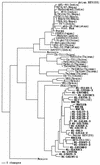Detection by reverse transcription-PCR and genetic characterization of field isolates of swine hepatitis E virus from pigs in different geographic regions of the United States
- PMID: 11923352
- PMCID: PMC140370
- DOI: 10.1128/JCM.40.4.1326-1332.2002
Detection by reverse transcription-PCR and genetic characterization of field isolates of swine hepatitis E virus from pigs in different geographic regions of the United States
Abstract
Hepatitis E virus (HEV) is an important public health concern in many developing countries. HEV is also endemic in some industrialized counties, including the United States. With our recent discovery of swine HEV in pigs that is genetically closely related to human HEV, hepatitis E is now considered a zoonotic disease. Human strains of HEV are genetically heterogenic. So far in the United States, only one strain of swine HEV has been identified and characterized from a pig. To determine the extent of genetic variations and the nature of swine HEV infections in U.S. pigs, we developed a universal reverse transcription-PCR (RT-PCR) assay that is capable of detecting genetically divergent strains of HEV. By using this universal RT-PCR assay, we tested fecal and serum samples of pigs of 2 to 4 months of age from 37 different U.S. swine farms for the presence of swine HEV RNA. Thirty-four of the 96 pigs (35%) and 20 of the 37 swine herds (54%) tested were positive for swine HEV RNA. The sequences of a 348-bp region within the ORF2 gene of 27 swine HEV isolates from different geographic regions were determined. Sequence analyses revealed that the 27 U.S. swine HEV isolates shared 88 to 100% nucleotide sequence identities with each other and 89 to 98% identities with the prototype U.S. strain of swine HEV. These U.S. swine HEV isolates are only distantly related to the Taiwanese strains of swine HEV, with about 74 to 78% nucleotide sequence identities; to most known human strains of HEV worldwide, with <79% sequence identities; and to avian HEV, with 54 to 56% sequence identities. Phylogenetic analysis showed that all the U.S. swine HEV isolates identified in this study clustered in the same genotype with the prototype U.S. swine HEV and the two U.S. strains of human HEV. The data from this study indicated that swine HEV is widespread and enzoonotic in U.S. swine herds and that, as is with human HEV, swine HEV isolates from different geographic regions of the world are also genetically heterogenic. These data further raise potential concerns for zoonosis, xenozoonosis, and food safety.
Figures

References
-
- Aggarwal, R., and K. Krawczynski. 2000. Hepatitis E: an overview and recent advances in clinical and laboratory research. J. Gastroenterol. Hepatol. 15:9-20. - PubMed
-
- Arankalle, V. A., M. K. Goverdhan, and K. Banerjee. 1994. Antibodies against hepatitis E virus in Old World monkeys. J. Viral Hepat. 1:125-129. - PubMed
-
- Clayson, E. T., B. L. Innis, K. S. Myint, S. Narupiti, D. W. Vaughn, S. Giri, P. Ranabhat, and M. P. Shrestha. 1995. Detection of hepatitis E virus infections among domestic swine in the Kathmandu Valley of Nepal. Am. J. Trop. Med. Hyg. 53:228-232. - PubMed
-
- Erker, J. C., S. M. Desai, G. G. Schlauder, G. J. Dawson, and I. K. Mushahwar. 1999. A hepatitis E virus variant from the United States: molecular characterization and transmission in cynomolgus macaques. J. Gen. Virol. 80:681-690. - PubMed
-
- Favorov, M. O., O. Nazarova, and H. S. Margolis. 1998. Is hepatitis E an emerging zoonotic disease? Am. J. Trop. Med. Hyg. 59:242. (Abstract.)
Publication types
MeSH terms
Associated data
- Actions
- Actions
- Actions
- Actions
- Actions
- Actions
- Actions
- Actions
- Actions
- Actions
- Actions
- Actions
- Actions
- Actions
- Actions
- Actions
- Actions
- Actions
- Actions
- Actions
- Actions
- Actions
- Actions
- Actions
- Actions
- Actions
- Actions
Grants and funding
LinkOut - more resources
Full Text Sources
Other Literature Sources

